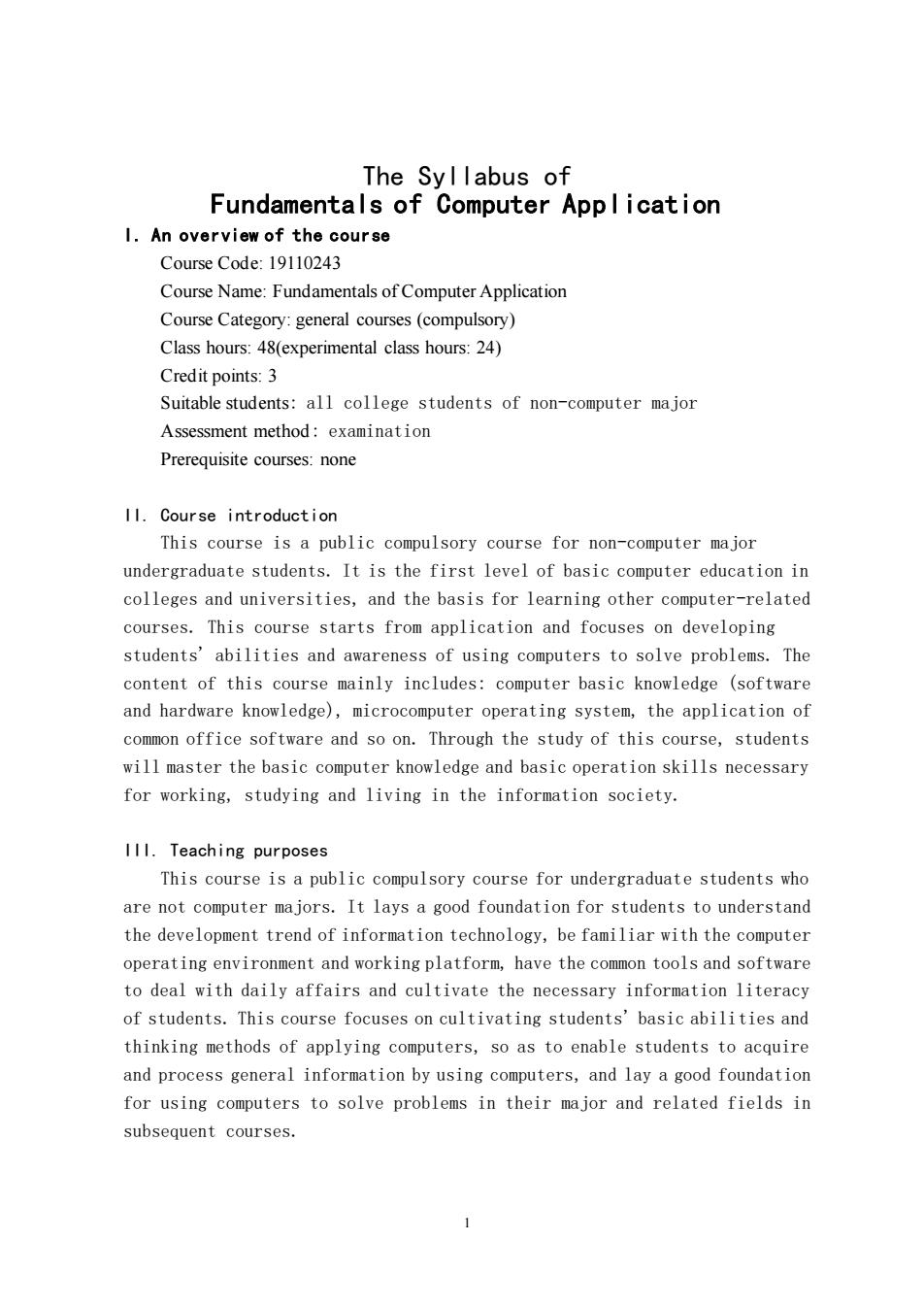
The Syllabus of Fundamentals of Computer Appl ication 1.An overview of the course Course Code:19110243 Course Name:Fundamentals of Computer Application Course Category:general courses (compulsory) Class hours:48(experimental class hours:24) Credit points:3 Suitable students:all college students of non-computer major Assessment method:examination Prerequisite courses:none I1.Course introduction This course is a public compulsory course for non-computer maior undergraduate students.It is the first level of basic computer education in colleges and universities,and the basis for learning other computer-related courses.This course starts from application and focuses on developing students'abilities and awareness of using computers to solve problems.The content of this course mainly includes:computer basic knowledge (software and hardware knowledge),microcomputer operating system,the application of common office software and so on.Through the study of this course,students will master the basic computer knowledge and basic operation skills necessary for working,studying and living in the information society. 111.Teaching purposes This course is a public compulsory course for undergraduate students who are not computer majors.It lays a good foundation for students to understand the development trend of information technology,be familiar with the computer operating environment and working platform,have the common tools and software to deal with daily affairs and cultivate the necessary information literacy of students.This course focuses on cultivating students'basic abilities and thinking methods of applying computers,so as to enable students to acquire and process general information by using computers,and lay a good foundation for using computers to solve problems in their major and related fields in subsequent courses
1 The Syllabus of Fundamentals of Computer Application I. An overview of the course Course Code: 19110243 Course Name: Fundamentals of Computer Application Course Category: general courses (compulsory) Class hours: 48(experimental class hours: 24) Credit points: 3 Suitable students: all college students of non-computer major Assessment method: examination Prerequisite courses: none II. Course introduction This course is a public compulsory course for non-computer major undergraduate students. It is the first level of basic computer education in colleges and universities, and the basis for learning other computer-related courses. This course starts from application and focuses on developing students' abilities and awareness of using computers to solve problems. The content of this course mainly includes: computer basic knowledge (software and hardware knowledge), microcomputer operating system, the application of common office software and so on. Through the study of this course, students will master the basic computer knowledge and basic operation skills necessary for working, studying and living in the information society. III. Teaching purposes This course is a public compulsory course for undergraduate students who are not computer majors. It lays a good foundation for students to understand the development trend of information technology, be familiar with the computer operating environment and working platform, have the common tools and software to deal with daily affairs and cultivate the necessary information literacy of students. This course focuses on cultivating students' basic abilities and thinking methods of applying computers, so as to enable students to acquire and process general information by using computers, and lay a good foundation for using computers to solve problems in their major and related fields in subsequent courses
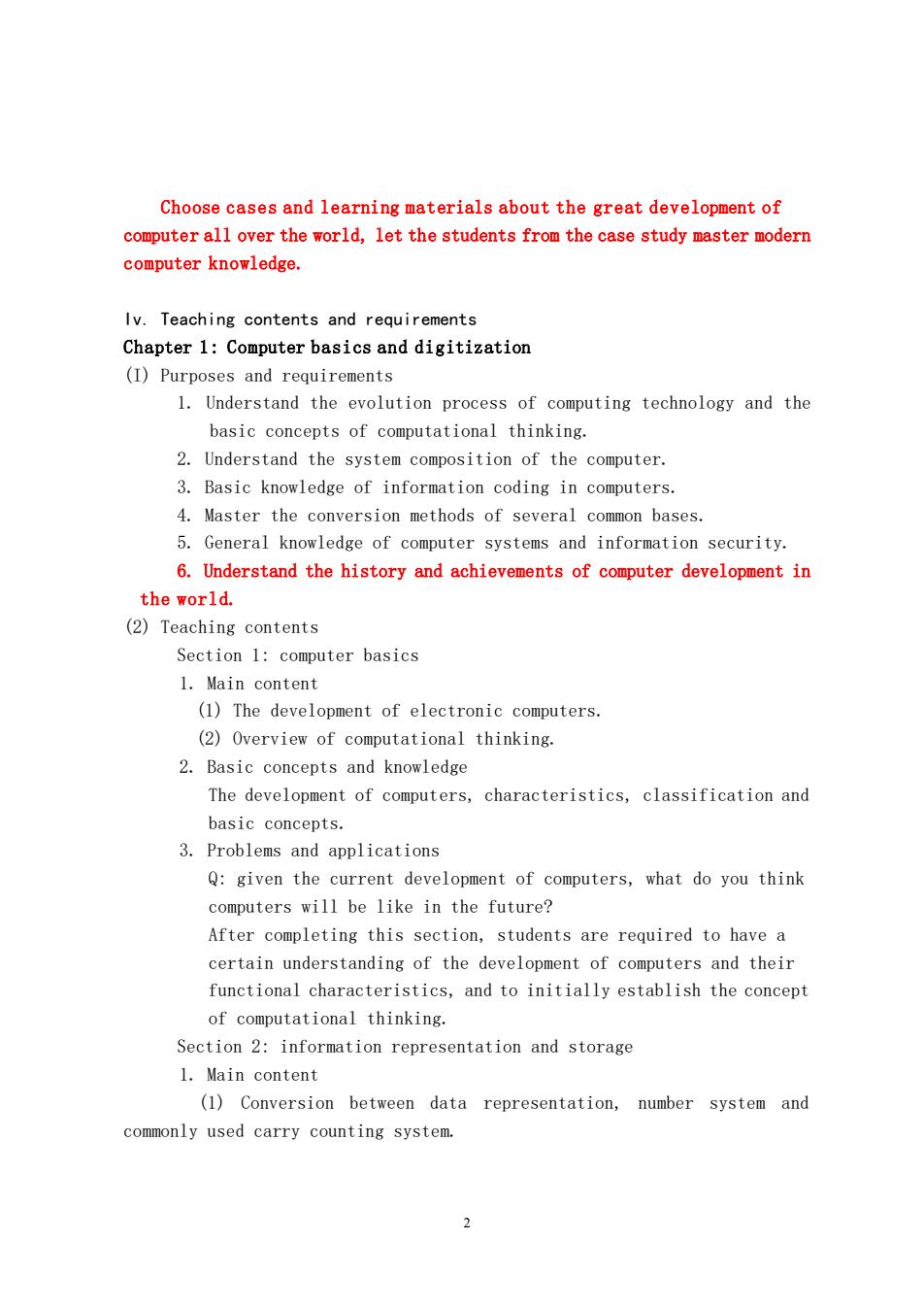
Choose cases and learning materials about the great development of computer all over the world,let the students from the case study master modern computer knowledge. Iv.Teaching contents and requirements Chapter 1:Computer basics and digitization (I)Purposes and requirements 1.Understand the evolution process of computing technology and the basic concepts of computational thinking. 2.Understand the system composition of the computer. 3.Basic knowledge of information coding in computers. 4.Master the conversion methods of several common bases 5.General knowledge of computer systems and information security. 6.Understand the history and achievements of computer development in the world. (2)Teaching contents Section 1:computer basics 1. Main content (1)The development of electronic computers. (2)Overview of computational thinking 2.Basic concepts and knowledge The development of computers,characteristics,classification and basic concepts. 3.Problems and applications Q:given the current development of computers,what do you think computers will be like in the future? After completing this section.students are required to have a certain understanding of the development of computers and their functional characteristics,and to initially establish the concept of computational thinking. Section 2:information representation and storage 1.Main content (1)Conversion between data representation,number system and commonly used carry counting system. 2
2 Choose cases and learning materials about the great development of computer all over the world, let the students from the case study master modern computer knowledge. Iv. Teaching contents and requirements Chapter 1: Computer basics and digitization (I) Purposes and requirements 1. Understand the evolution process of computing technology and the basic concepts of computational thinking. 2. Understand the system composition of the computer. 3. Basic knowledge of information coding in computers. 4. Master the conversion methods of several common bases. 5. General knowledge of computer systems and information security. 6. Understand the history and achievements of computer development in the world. (2) Teaching contents Section 1: computer basics 1. Main content (1) The development of electronic computers. (2) Overview of computational thinking. 2. Basic concepts and knowledge The development of computers, characteristics, classification and basic concepts. 3. Problems and applications Q: given the current development of computers, what do you think computers will be like in the future? After completing this section, students are required to have a certain understanding of the development of computers and their functional characteristics, and to initially establish the concept of computational thinking. Section 2: information representation and storage 1. Main content (1) Conversion between data representation, number system and commonly used carry counting system
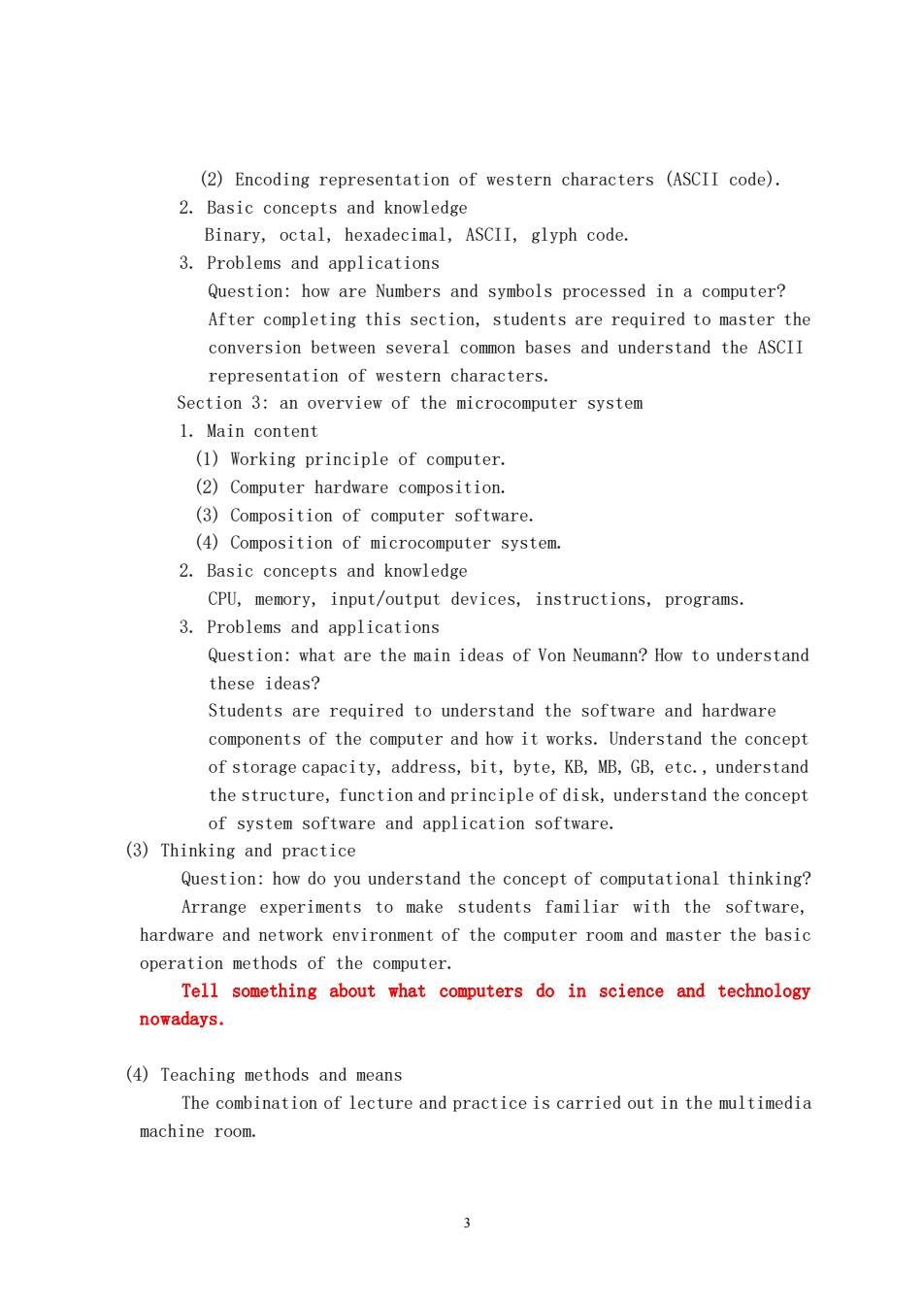
(2)Encoding representation of western characters (ASCII code). 2.Basic concepts and knowledge Binary,octal,hexadecimal,ASCII,glyph code. 3.Problems and applications Question:how are Numbers and symbols processed in a computer? After completing this section,students are required to master the conversion between several common bases and understand the ASCII representation of western characters. Section 3:an overview of the microcomputer system 1.Main content (1)Working principle of computer (2)Computer hardware composition. (3)Composition of computer software (4)Composition of microcomputer system. 2.Basic concepts and knowledge CPU,memory,input/output devices,instructions,programs. 3.Problems and applications Question:what are the main ideas of Von Neumann?How to understand these ideas? Students are required to understand the software and hardware components of the computer and how it works.Understand the concept of storage capacity.address.bit.byte.KB.MB.GB.etc..understand the structure,function and principle of disk,understand the concept of system software and application software. (3)Thinking and practice Question:how do you understand the concept of computational thinking? Arrange experiments to make students familiar with the software, hardware and network environment of the computer room and master the basic operation methods of the computer. Tell something about what computers do in science and technology nowadays. (4)Teaching methods and means The combination of lecture and practice is carried out in the multimedia machine room. 3
3 (2) Encoding representation of western characters (ASCII code). 2. Basic concepts and knowledge Binary, octal, hexadecimal, ASCII, glyph code. 3. Problems and applications Question: how are Numbers and symbols processed in a computer? After completing this section, students are required to master the conversion between several common bases and understand the ASCII representation of western characters. Section 3: an overview of the microcomputer system 1. Main content (1) Working principle of computer. (2) Computer hardware composition. (3) Composition of computer software. (4) Composition of microcomputer system. 2. Basic concepts and knowledge CPU, memory, input/output devices, instructions, programs. 3. Problems and applications Question: what are the main ideas of Von Neumann? How to understand these ideas? Students are required to understand the software and hardware components of the computer and how it works. Understand the concept of storage capacity, address, bit, byte, KB, MB, GB, etc., understand the structure, function and principle of disk, understand the concept of system software and application software. (3) Thinking and practice Question: how do you understand the concept of computational thinking? Arrange experiments to make students familiar with the software, hardware and network environment of the computer room and master the basic operation methods of the computer. Tell something about what computers do in science and technology nowadays. (4) Teaching methods and means The combination of lecture and practice is carried out in the multimedia machine room
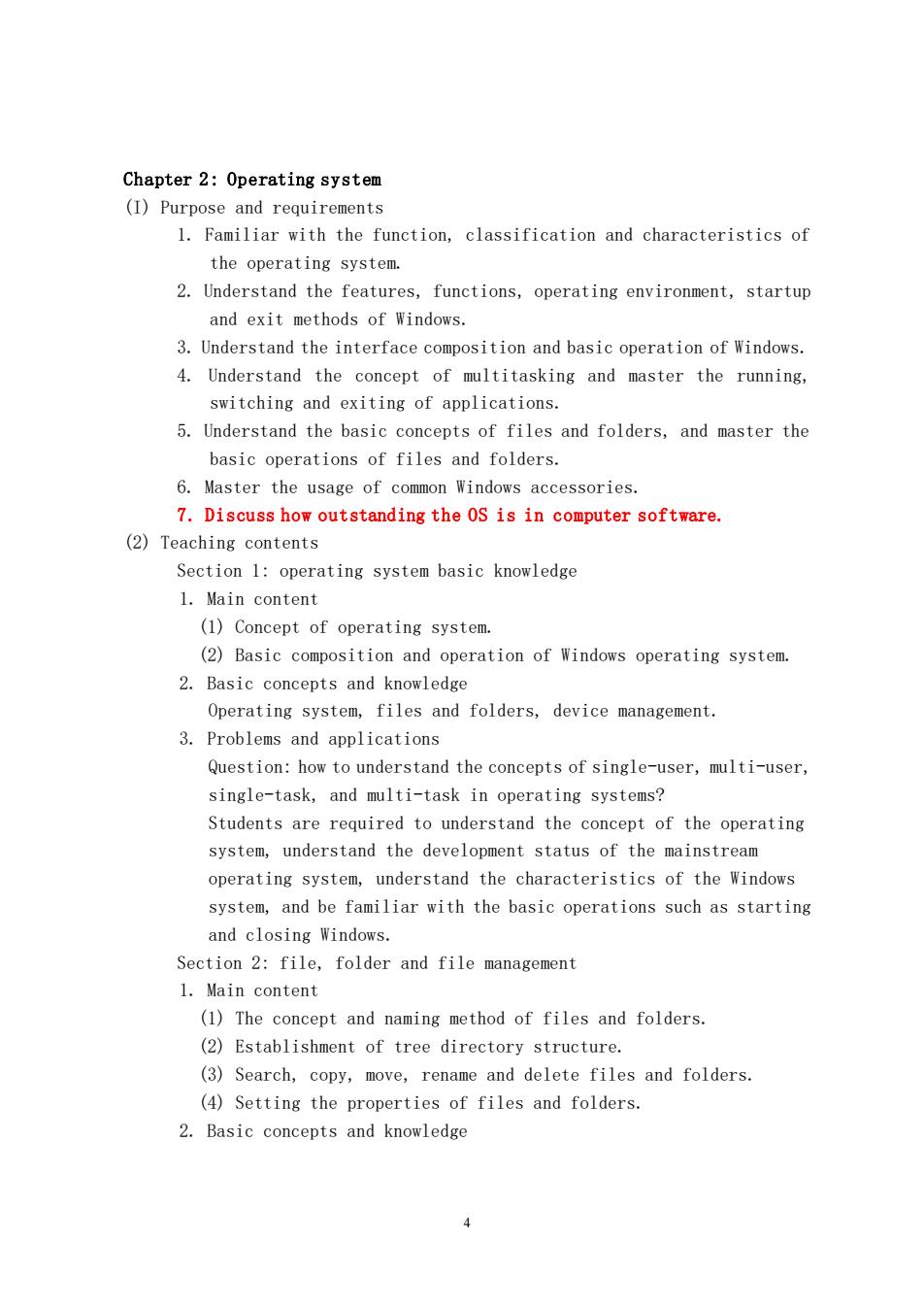
Chapter 2:Operating system (I)Purpose and requirements 1.Familiar with the function,classification and characteristics of the operating system. 2.Understand the features,functions,operating environment,startup and exit methods of Windows. 3.Understand the interface composition and basic operation of Windows. 4.Understand the concept of multitasking and master the running, switching and exiting of applications. 5.Understand the basic concepts of files and folders,and master the basic operations of files and folders. 6.Master the usage of common Windows accessories. 7.Discuss how outstanding the oS is in computer software. (2)Teaching contents Section 1:operating system basic knowledge 1.Main content (1)Concept of operating system. (2)Basic composition and operation of Windows operating system. 2.Basic concepts and knowledge Operating system,files and folders,device management. 3.Problems and applications Question:how to understand the concepts of single-user,multi-user, single-task,and multi-task in operating systems? Students are required to understand the concept of the operating system,understand the development status of the mainstream operating system,understand the characteristics of the Windows system,and be familiar with the basic operations such as starting and closing windows. Section 2:file,folder and file management 1.Main content (1)The concept and naming method of files and folders. (2)Establishment of tree directory structure. (3)Search,copy,move,rename and delete files and folders. (4)Setting the properties of files and folders. 2.Basic concepts and knowledge 4
4 Chapter 2: Operating system (I) Purpose and requirements 1. Familiar with the function, classification and characteristics of the operating system. 2. Understand the features, functions, operating environment, startup and exit methods of Windows. 3. Understand the interface composition and basic operation of Windows. 4. Understand the concept of multitasking and master the running, switching and exiting of applications. 5. Understand the basic concepts of files and folders, and master the basic operations of files and folders. 6. Master the usage of common Windows accessories. 7. Discuss how outstanding the OS is in computer software. (2) Teaching contents Section 1: operating system basic knowledge 1. Main content (1) Concept of operating system. (2) Basic composition and operation of Windows operating system. 2. Basic concepts and knowledge Operating system, files and folders, device management. 3. Problems and applications Question: how to understand the concepts of single-user, multi-user, single-task, and multi-task in operating systems? Students are required to understand the concept of the operating system, understand the development status of the mainstream operating system, understand the characteristics of the Windows system, and be familiar with the basic operations such as starting and closing Windows. Section 2: file, folder and file management 1. Main content (1) The concept and naming method of files and folders. (2) Establishment of tree directory structure. (3) Search, copy, move, rename and delete files and folders. (4) Setting the properties of files and folders. 2. Basic concepts and knowledge
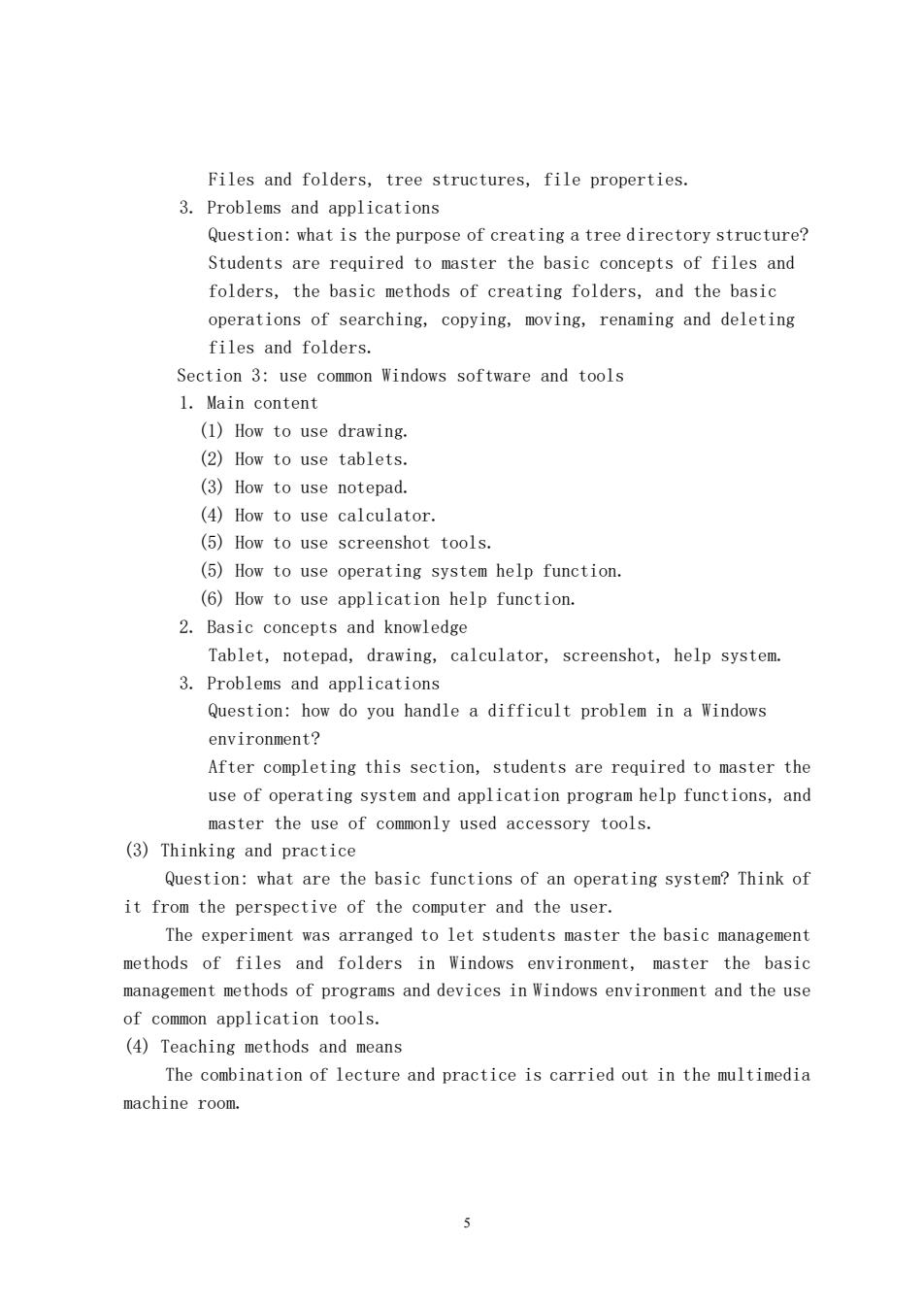
Files and folders,tree structures,file properties. 3.Problems and applications Question:what is the purpose of creating a tree directory structure? Students are required to master the basic concepts of files and folders.the basic methods of creating folders.and the basic operations of searching,copying,moving,renaming and deleting files and folders. Section 3:use common Windows software and tools 1.Main content (1)How to use drawing. (2)How to use tablets. (3)How to use notepad. (4)How to use calculator (5)How to use screenshot tools. (5)How to use operating system help function (6)How to use application help function. 2.Basic concepts and knowledge Tablet,notepad,drawing,calculator,screenshot,help system. 3.Problems and applications Question:how do you handle a difficult problem in a Windows environment? After completing this section.students are required to master the use of operating system and application program help functions,and master the use of commonly used accessory tools. (3)Thinking and practice Question:what are the basic functions of an operating system?Think of it from the perspective of the computer and the user. The experiment was arranged to let students master the basic management methods of files and folders in Windows environment,master the basic management methods of programs and devices in Windows environment and the use of common application tools. (4)Teaching methods and means The combination of lecture and practice is carried out in the multimedia machine room. 5
5 Files and folders, tree structures, file properties. 3. Problems and applications Question: what is the purpose of creating a tree directory structure? Students are required to master the basic concepts of files and folders, the basic methods of creating folders, and the basic operations of searching, copying, moving, renaming and deleting files and folders. Section 3: use common Windows software and tools 1. Main content (1) How to use drawing. (2) How to use tablets. (3) How to use notepad. (4) How to use calculator. (5) How to use screenshot tools. (5) How to use operating system help function. (6) How to use application help function. 2. Basic concepts and knowledge Tablet, notepad, drawing, calculator, screenshot, help system. 3. Problems and applications Question: how do you handle a difficult problem in a Windows environment? After completing this section, students are required to master the use of operating system and application program help functions, and master the use of commonly used accessory tools. (3) Thinking and practice Question: what are the basic functions of an operating system? Think of it from the perspective of the computer and the user. The experiment was arranged to let students master the basic management methods of files and folders in Windows environment, master the basic management methods of programs and devices in Windows environment and the use of common application tools. (4) Teaching methods and means The combination of lecture and practice is carried out in the multimedia machine room